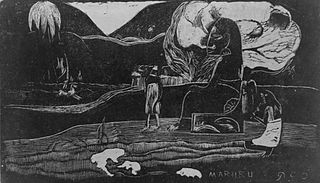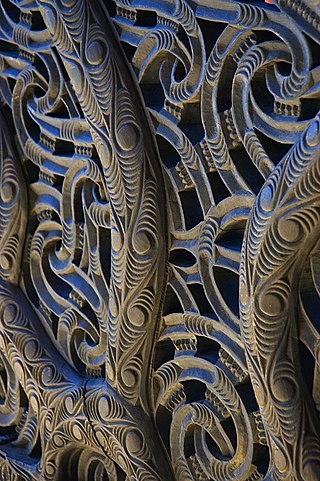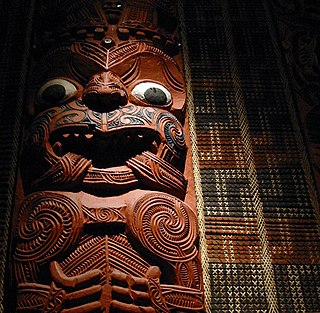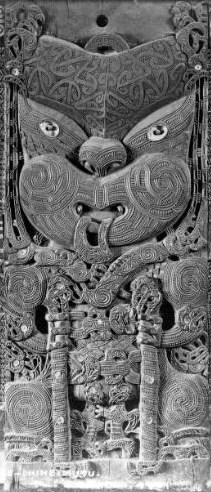Māui (Maui) is the great culture hero and trickster in Polynesian mythology. Very rarely was Māui actually worshipped, being less of a deity and more of a folk hero. His origins vary from culture to culture, but many of his main exploits remain relatively similar.

Hina is the name assigned to a number of Polynesian deities. The name Hina usually relates to a powerful female force who has dominion over a specific entity. Some variations of the name Hina include Sina, Hanaiakamalama, and Ina. Even within a single culture, Hina could refer to multiple goddesses and the distinction between the different identities are not always clear. In Hawaiian mythology, the name is usually paired with words which explain or identify the goddess and her power such as Hina-puku-iʻa (Hina-gathering-seafood) the goddess of fishermen, and Hina-ʻopu-hala-koʻa who gave birth to all reef life.
Tangaroa is the great atua of the sea, lakes, rivers, and creatures that live within them, especially fish, in Māori mythology. As Tangaroa-whakamau-tai he exercises control over the tides. He is sometimes depicted as a whale.

In Māori mythology, Tāwhaki is a semi-supernatural being associated with lightning and thunder.
Tongan narrative is a variant of a more general Polynesian narrative in Tonga.
Ruatapu was a son of the great chief Uenuku, and a master canoeist in Polynesian tradition who is said to have lived around 30 generations ago. Most Māori stories agree he was an older half-brother of Paikea and 69 other sons, while traditions recorded from the Cook Islands sometimes state he was Uanuku Rakeiora's only son.
Kaha'i is a handsome Polynesian demigod whose exploits were popular in many Polynesian mythologies.
In Māori mythology, Irawaru is the origin of the dog. He is the husband of Hinauri, the sister of Māui. Māui becomes annoyed with Irawaru and stretches out his limbs, turning him into a dog. When Hinauri asks Māui if he has seen her husband, Māui tells her to call "Moi! Moi!" whereupon the poor dog runs up to Hinauri. Learning the truth, she throws herself to Tangaroa never to be seen again.
Hemā is a figure in both Hawaiian and Maori mythology.

In Māori mythology, Punga is a supernatural being, the ancestor of sharks, lizards, rays, and all deformed, ugly things. All ugly and strange animals are Punga's children. Hence the saying Te aitanga a Punga used to describe an ugly person.
In Māori mythology, Te Wheke-a-Muturangi is a monstrous octopus destroyed in Whekenui Bay, Tory Channel or at Patea by Kupe the navigator.

In Māori mythology, Tinirau is a guardian of fish. He is a son of Tangaroa, the god of the sea. His home at Motutapu is surrounded with pools for breeding fish. He also has several pet whales.

Melanesian mythology refers to the folklore, myths, and religions of Melanesia, a region in Southwest Oceania that encompasses the archipelagos of New Guinea, the Torres Strait Islands, Solomon Islands, Vanuatu, New Caledonia and Fiji.

Māori mythology and Māori traditions are two major categories into which the remote oral history of New Zealand's Māori may be divided. Māori myths concern fantastic tales relating to the origins of what was the observable world for the pre-European Māori, often involving gods and demigods. Māori tradition concerns more folkloric legends often involving historical or semi-historical forebears. Both categories merge in whakapapa to explain the overall origin of the Māori and their connections to the world which they lived in.
In Māori mythology, Hinauri is the sister of Māui and the wife of Irawaru. Māui becomes annoyed with Irawaru and stretches out his limbs, turning him into a dog. When Hinauri asks Māui if he has seen her husband, Māui tells her to call “Moi! Moi!” whereupon the poor dog runs up, and Hinauri, learning the truth, throws herself into the sea.
Uenuku is an atua of rainbows and a prominent ancestor in Māori tradition. Māori believed that the rainbow's appearance represented an omen, and one kind of yearly offering made to him was that of the young leaves of the first planted kūmara crop. He was a tribal war god invoked before battles, particularly in the northern half of the country. It was said that if a taua appeared under the arch of the rainbow, it would be defeated in battle, and likewise, if they appeared to either side of the rainbow, they would be victorious. The Māori identified hawk feathers and a particular star called Uenuku as being sacred to him.
Sāngone, was the name of a turtle from divine origin and featuring in Tongan myths about the Tuʻi Tonga king named Tuʻitātui in the beginning of the 12th century AD. Part of the history features prominently in a famous lakalaka written by queen Sālote somewhere around 1940, when the shell, claimed to be the original one from Sāngone herself, was transferred to the Tupou College museum.
The story cycle around Kae and Sinilau is well known in Polynesian mythology, found in several places. This article describes the Tongan version, of which the main source is an old poem published in 1876, and some other, incomplete manuscripts.

Sina and the Eel is a myth of origins in Samoan mythology, which explains the origins of the first coconut tree.

In Māori tradition of New Zealand, Tama-te-kapua, also spelt Tamatekapua and Tama-te-Kapua and also known as Tama, was the captain of the Arawa canoe which came to New Zealand from Polynesia in about 1350.








